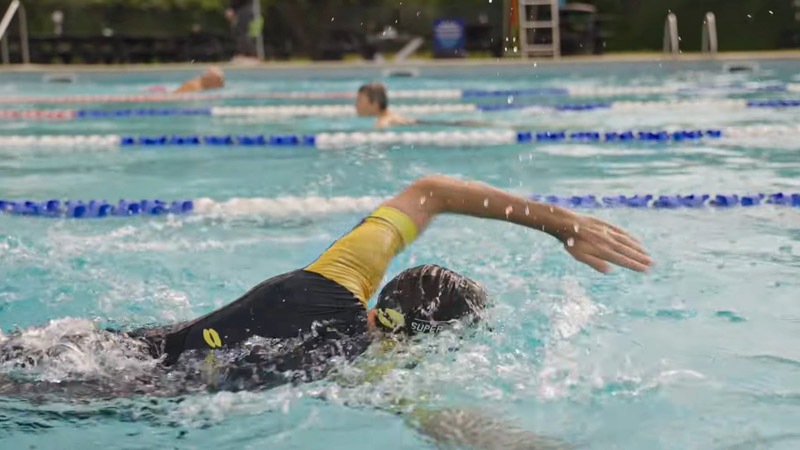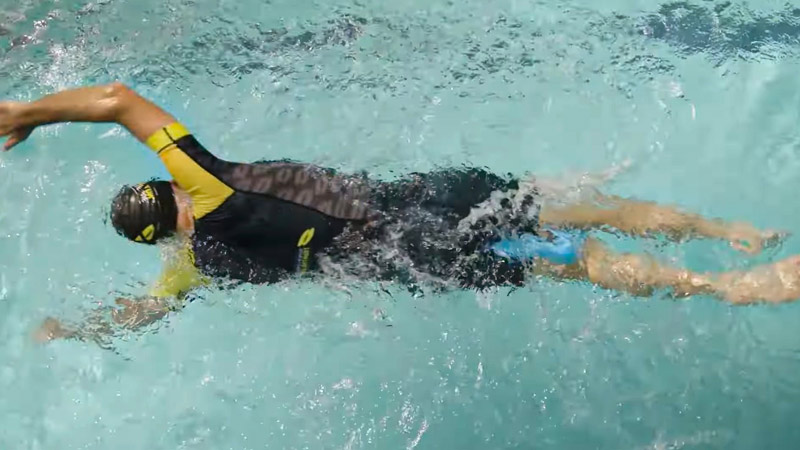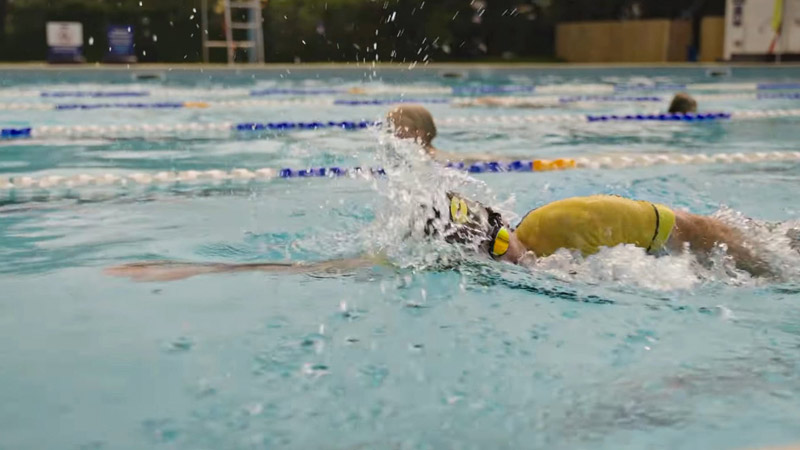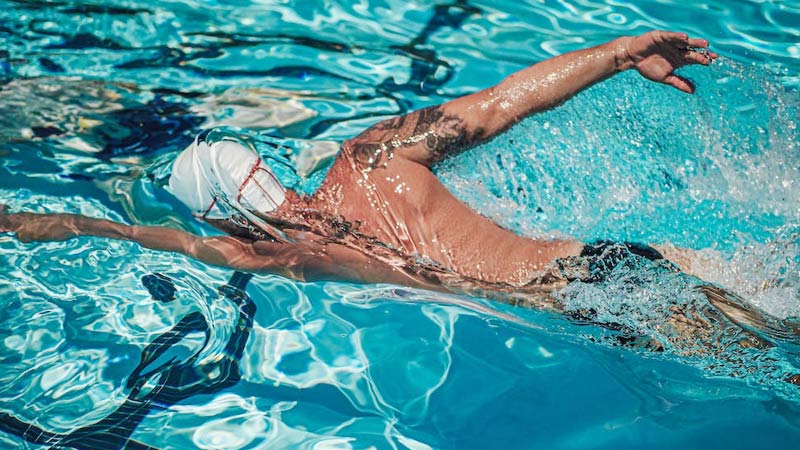Swimming is often touted as a therapeutic haven for individuals grappling with rotator cuff injuries, a common ailment affecting the shoulder.
This low-impact exercise boasts a myriad of benefits, offering a gentle yet effective approach to rehabilitation.
The buoyancy of water reduces stress on joints, making swimming an ideal option. Its diverse strokes enhance the range of motion, promoting flexibility crucial for recovery.
With water providing resistance, muscles can be strengthened gradually without overburdening the injured area.
Beyond its rehabilitative merits, swimming contributes to cardiovascular health, making it a holistic and well-rounded choice for those seeking to navigate the challenges of a rotator cuff injury.
Is Swimming Good for Rotator Cuff Injury?
Swimming can be a beneficial and therapeutic exercise for individuals with a rotator cuff injury.
The rotator cuff is a group of muscles and tendons surrounding the shoulder joint, and injuries to this area are relatively common.
While it’s essential to consult with a healthcare professional before starting any exercise program, swimming is often recommended for individuals with rotator cuff injuries for several reasons.
Here are the reasons why is swimming good for rotator cuff rehab:
Low Impact
The low-impact nature of swimming is particularly advantageous for individuals with rotator cuff injuries.
High-impact exercises, such as running or weightlifting, can exacerbate shoulder pain and hinder the healing process.
Swimming, on the other hand, reduces stress on the joints, providing a gentle environment for rehabilitation.
Range of Motion
Swimming involves a variety of strokes that engage the shoulder muscles through different planes of movement.
Freestyle, backstroke, breaststroke, and butterfly strokes encourage a full range of motion in the shoulders.
This can help prevent stiffness and promote flexibility, key factors in the recovery of rotator cuff injuries.
Strengthening Without Overloading
Water resistance during swimming serves as a natural form of resistance training. This allows for muscle strengthening without the risk of overloading the injured shoulder.
Gradual progression in resistance, perhaps by using swimming aids like paddles, can be incorporated as part of a structured rehabilitation program.
Muscle Endurance
Swimming is an excellent way to enhance muscle endurance. The sustained nature of swimming requires continuous engagement of the shoulder muscles, contributing to improved endurance over time.
This is crucial for individuals with rotator cuff injuries, as enhanced endurance can provide better support for the shoulder joint.
Pain Management
The buoyancy of water not only reduces the impact on the shoulder but also helps manage pain associated with rotator cuff injuries.
The weightlessness experienced in water can be particularly beneficial for those who find weight-bearing exercises on land uncomfortable. Swimming provides a controlled environment where individuals can exercise with reduced pain.
Cardiovascular Health
While focusing on shoulder rehabilitation, it’s important not to neglect overall cardiovascular health.
Swimming is an effective aerobic exercise that elevates the heart rate, improving cardiovascular fitness.
This is crucial for maintaining overall health during the recovery process and can positively impact the body’s ability to heal.
Swimming After Rotator Cuff Surgery

Swimming can play a crucial role in the rehabilitation process after rotator cuff surgery, but it’s essential to approach it with caution and follow the guidance of your healthcare team.
Rotator cuff surgery involves repairing damaged tendons or muscles in the shoulder, and the recovery period varies based on the extent of the surgery and individual factors.
Here’s how swimming can be beneficial after rotator cuff surgery:
Gradual Reintroduction to Activity
After rotator cuff surgery, the shoulder needs time to heal, and it’s important to start with gentle movements. Swimming provides a low-impact environment, allowing for a gradual reintroduction to physical activity.
The buoyancy of water minimizes stress on the healing shoulder, making it a suitable option for early-stage rehabilitation.
Range of Motion Improvement
Swimming engages the shoulder in various ranges of motion, promoting flexibility and preventing stiffness.
Controlled movements in the water can aid in restoring the normal range of motion in the shoulder joint, a crucial aspect of recovery after surgery.
Muscle Strengthening in a Controlled Setting
As the shoulder heals, gentle swimming can be incorporated to facilitate muscle strengthening. Water resistance provides a controlled environment for gradually rebuilding strength in the repaired muscles and tendons without subjecting them to excessive strain.
Pain Management
Swimming can assist in managing post-surgery pain. The water’s buoyancy supports the body, reducing the impact on the healing shoulder and making movement less painful. This can contribute to a more comfortable rehabilitation experience.
Cardiovascular Conditioning
Maintaining cardiovascular fitness is important for overall health, even during the recovery period.
Swimming allows for cardiovascular conditioning without placing undue stress on the healing shoulder.
Starting with slow and controlled laps and gradually increasing intensity can help in achieving cardiovascular benefits.
Supervised Rehabilitation
It’s crucial to engage in swimming as part of a supervised rehabilitation program. Physical therapists or healthcare professionals can guide you through appropriate swimming exercises, ensuring that you progress at a pace that aligns with your recovery timeline.
They can also identify any movements or strokes that may be contraindicated during the early stages of recovery.
Swimming With a Torn Rotator Cuff

Swimming with a torn rotator cuff can be a complex decision that depends on the severity of the tear, the specific circumstances of the injury, and individual tolerance levels.
While swimming is often recommended for rehabilitation, it’s crucial to approach it cautiously and under the guidance of a healthcare professional.
Here are some considerations:
Consultation with a Healthcare Professional
Before engaging in any form of exercise, especially swimming, it’s essential to consult with a healthcare professional, preferably a physician or physical therapist, to assess the severity of the torn rotator cuff and determine the appropriate course of action. They can provide specific guidance tailored to your condition.
Choosing Appropriate Strokes
Not all swimming strokes may be suitable for individuals with a torn rotator cuff. While some strokes, such as the freestyle and backstroke, may be less stressful on the shoulders, others like the butterfly or breaststroke could exacerbate the injury.
Your healthcare professional can advise on which strokes are safer based on your specific situation.
Buoyancy and Reduced Impact
One of the advantages of swimming is the buoyancy of water, which reduces the impact on the joints. This can be beneficial for individuals with a torn rotator cuff, as it minimizes stress on the injured shoulder.
However, it’s crucial to start with gentle movements and progress gradually to avoid overloading the affected area.
Range of Motion Exercises
Swimming allows for a wide range of motion in the shoulders, which can be beneficial for maintaining flexibility and preventing stiffness associated with a torn rotator cuff.
Gentle stretching exercises in the water may aid in improving range of motion without causing excessive strain.
Pain Management
Swimming can be a viable option for managing pain associated with a torn rotator cuff. The water’s buoyancy supports the body, making movements less painful compared to weight-bearing exercises on land.
However, any increase in pain during or after swimming should be promptly reported to your healthcare professional.
Individualized Approach
Each torn rotator cuff injury is unique, and the approach to swimming should be individualized.
Your healthcare professional can help design a rehabilitation plan that considers the specific details of your injury, ensuring that you engage in activities that promote healing without causing further harm.
Avoid Overexertion
While swimming can be therapeutic, it’s important not to overexert yourself, especially if you have a torn rotator cuff.
Pushing too hard or engaging in strenuous activities in the water can lead to complications and hinder the healing process.
Best Swimming Stroke for Rotator Cuff Injury

When dealing with a rotator cuff injury, choosing the right swimming stroke is crucial to promote rehabilitation while minimizing stress on the injured shoulder.
While individual preferences and tolerances vary, certain strokes are generally considered more shoulder-friendly for individuals with rotator cuff issues.
Here are some considerations:
Backstroke
The backstroke is often recommended for individuals with rotator cuff injuries. This stroke involves a continuous, alternating arm motion that is generally easier on the shoulders.
Since the arms move symmetrically and there is no overhead reaching, backstroke places less strain on the rotator cuff muscles.
Freestyle
Freestyle is another stroke that can be suitable for those with rotator cuff injuries, particularly when performed with proper technique.
The key is to focus on a relaxed and controlled arm movement, avoiding forceful overhead reaches. Breathing on both sides can help distribute the load more evenly.
Sidestroke
Sidestroke is characterized by lateral arm movement, which can be less demanding on the shoulders.
This stroke is often recommended for individuals with shoulder issues as it reduces stress on the rotator cuff. The slower pace of sidestroke can also be beneficial for those recovering from injuries.
Elementary Backstroke
Elementary backstroke is a simple and gentle stroke that involves a frog-like kick and a backward arm movement. It is considered one of the least strenuous strokes for the shoulders.
This stroke is often recommended for rehabilitation because it minimizes strain on the rotator cuff while providing a good overall workout.
Breaststroke
Breaststroke can be adapted to be more shoulder-friendly by modifying the arm movements. Instead of a wide circular motion, a narrower and shallower pull can be employed.
This modification reduces stress on the rotator cuff while still allowing for a beneficial breaststroke workout.
FAQS
Can I swim with a rotator cuff injury?
Swimming can be a beneficial exercise for rotator cuff injuries, but it’s essential to consult with a healthcare professional before starting any swimming regimen.
Is swimming advisable with a rotator cuff tear?
Swimming can be considered as part of rehabilitation for a rotator cuff tear but the intensity of swimming should be carefully guided by healthcare professionals to prevent exacerbating the injury.
How can swimming help with a rotator cuff injury?
Swimming may aid in rehabilitation by providing a low-impact environment, promoting range of motion, and assisting in muscle strengthening.
What precautions should I take when swimming with a rotator cuff injury?
When swimming with a rotator cuff injury, start with gentle strokes, avoid overexertion, and pay attention to any pain or discomfort.
Can I continue swimming after a rotator cuff injury?
Continuing swimming after a rotator cuff injury may be possible with proper guidance.
Your healthcare professional will help determine the appropriate strokes, intensity, and progression based on your specific situation.
Wrap Up
Swimming emerges as a promising avenue for individuals dealing with rotator cuff injuries. Its low-impact nature, combined with the buoyancy of water, provides a gentle yet effective environment for rehabilitation.
The varied strokes encourage a broad range of motion, promoting flexibility and preventing stiffness.
Additionally, the resistance offered by water aids in muscle strengthening without overburdening the injured area.
While swimming holds considerable therapeutic potential, it is crucial to approach it under the guidance of healthcare professionals, ensuring a tailored and safe rehabilitation program.
When integrated thoughtfully, swimming can be a valuable component in the recovery journey, fostering improved mobility and overall shoulder health.







